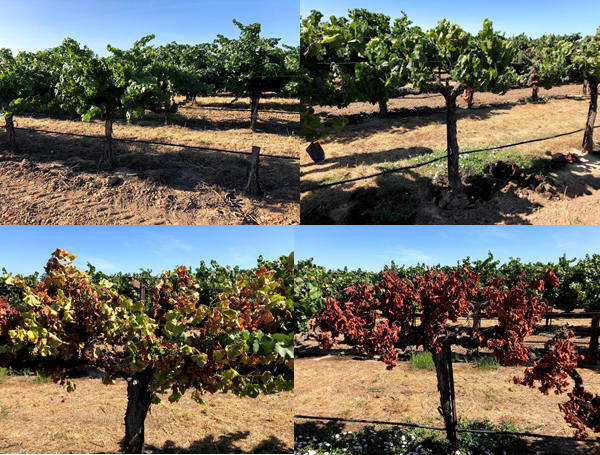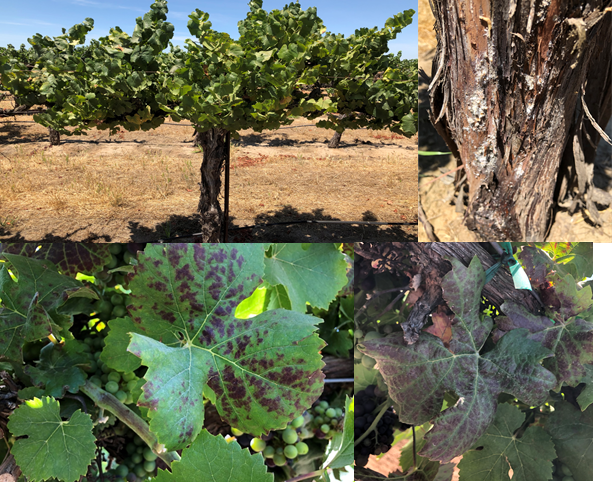Understanding Sudden Vine Collapse in California
Akif Eskalen1, Erin Hardy1, Karina Elfar1, Maher Al-Rwahnih1, Charlie Starr2, Stephanie Bolton3, Neil McRoberts1, Mark Battany4, Larry Bettiga5, Kari Arnold6, George Zhuang7, Gabriel Torres8.
1-Department of Plant Pathology, UC Davis
2-Pest Control Advisor
3-Lodi Winegrape Commission
4-UCCE Farm, Advisor in San Luis Obispo/Santa Barbara counties
5-UCCE Farm Advisor in Monterey, San Benito and Santa Cruz Counties
6-UCCE Farm Advisor in Stanislaus County
7-UCCE Farm Advisor in Fresno County
8-UCCE Farm Advisor in Tulare County
This article is written in the style of a scientific journal article, where citations are provided in text. Numbers inserted into the text indicate the citation used (citations provided at the end of the article).
Within the last ten years, throughout the Lodi AVA of California, vineyards have experienced Sudden Vine Collapse in which patches of grapevines within vineyards, especially on Freedom rootstock, quickly die with no apparent cause. Growers have reported this issue with symptoms that are not consistent with other known diseases of grapevines.
While the disease was initially called Mystery Vine Decline, it has since been renamed as Sudden Vine Collapse (SVC) due to its ability to cause a complete collapse of grapevines (FIGURE 1). Since our initial identification in the Lodi AVA, we have also confirmed SVC in several vineyards in Stanislaus, Monterey, San Luis Obispo, Fresno, Tulare and Kern counties.
In 2018, the disease reached a level of economic damage where it was affecting sufficient numbers of grape growers to bring it greater attention and, by 2019, a meeting on the topic held in Lodi, Calif., attracted 140 people from all over the state.9 The work presented here builds upon years of data collection spearheaded by Charlie Starr, Paul Verdegaal and many other scientists who were invited to visit collapsing vineyards between 2010-2019.
FIGURE 1
A typical mystery (sudden) vine collapse site – in the collapsing “patch” are empty spaces where dead vines were removed, dead vines, recently collapsed vines, collapsing vines and healthy vines. (Picture credit Stephanie Bolton, 2018).
SVC Symptoms
The most common symptoms are stunted shoot growth (FIGURE 2), and whole, sudden vine collapse (known as apoplexy) in a circular patch within a vineyard. Vines produce fruit and appear healthy except for the stunted growth, and then within a few weeks, entire vines are dead, dried out, and even splitting along the trunk in some cases.
When many cases of SVC-symptomatic vines were closely examined, the graft union showed a swollen scion, a discolored necrotic line that could result in girdling in the phloem tissues and, most importantly, an apparent lack of feeder roots. Additionally, rootstocks often showed a wedge-shaped canker in the wood and grayish-brown to purple lesions in the bark of the large scaffold roots. The symptoms look similar to grapevine trunk disease (GTD) which is one of the most common and aggressive grapevine trunk diseases of grapevine.
In this plot study, samples were taken from four different vineyards (one Cabernet Sauvignon, two Chardonnay, and one Pinot Noir on Freedom rootstock) in the Lodi AVA only in order to minimize the effects of microclimate and environmental conditions for this research.
FIGURE 2
Different stages of Sudden Vine Collapse that were used as a sampling strategy for the study. A) healthy looking appearance, B) stunted shoots, C) declining and D) advanced decline (Picture credit Eskalen Lab, 2019)
Synergy Between Grapevine Vitiviruses and Grapevine Leafroll Viruses
Vitiviruses are a class of viruses associated with rugose wood complex diseases.10,11 An interactive relationship between vitiviruses and leafroll viruses has been characterized in grapevines. Vitiviruses such as grapevine viruses -A and -B (GVA and GVB) have been found more frequently in the presence of leafroll-associated viruses (GLRa-1, -2 or -3) than in their absence.10
Vitivirus-associated stem pitting symptoms were correlated with a leafroll virus co-infection in one study by A. Rowhani et al.11 Leafroll viruses interact synergistically with vitiviruses to magnify the detrimental symptoms in infected vines. In the presence of a leafroll virus co-infection, vitivirus titer (or amount of virus particles) was found to be significantly higher than in infected vines where leaf-roll viruses were absent.10 In some cases this synergistic effect has been shown to lead to increased severity of leafroll disease symptoms.10,11
Virus-Sensitive Rootstocks
The possible association between SVC and certain virus-sensitive rootstocks (Freedom, Harmony, Schwarzmann, 1613C and 420A, among others) is important to consider.3 In fact, something known as “virus-induced rootstock incompatibility” has been described in scientific literature. D. Golino et al 2003, reported that rootstock response to virus infection depends on the rootstock genotype and the virus type. Rootstocks differ widely in virus susceptibility and rootstock growth and survival is affected by virus infection. No graft union symptoms are necessary for detrimental virus effects to appear, although if present, they may be indicative of rootstock decline.3,4
The symptoms of viral infection may be negligible (less damaging) in an own-rooted grape genotype but devastating when that genotype is grafted onto rootstock. The subsequent graft incompatibility at the time of planting results in weak growth and eventual death of the vine.
The rootstocks Freedom, Harmony, Schwarzmann, 1613C and 420A3 have been shown to be affected by virus inoculation from some asymptomatic scions.4,5,6 Additionally, grapevine leafroll-associated virus-2 and grapevine virus-B co-infection is known to cause virus-induced vine decline.6,7
Study and Working Hypothesis
After years of testing to rule out several possible causes for the mysteriously collapsing vines, four vineyards exhibiting SVC in the Lodi AVA were sampled for viruses and fungi in July 2019. From each vineyard, three vines (one healthy-looking, one collapsing and one collapsed vine) were selected for testing. Samples were collected from the rootstock and scion separately, including roots, cordons, spurs and leaves of the selected vines FIGURE 3.
Figure 3: Dead arm and internal symptoms caused by the different fungal pathogens of grapevine trunk diseases. (Picture credit Eskalen Lab, 2019)
Samples from each type of vine tissue were plated and cultured on selective media for the recovery of potential pathogens on potato dextrose agar amended with tetracycline 0.01 mg/L was used for the recovery of the fungi, and on nutrient agar for bacteria growth. Isolated fungi were identified using PCR (polymerase chain reaction, a method which identifies microbes based on their DNA).
For the leaf and rootstock samples, high-throughput sequencing (HTS) was performed to characterize the entire viral sequence profile of the vines. HTS technologies are capable of sequencing multiple DNA molecules in parallel, enabling hundreds of millions of DNA molecules to be sequenced at one time.
Additionally, to assess the extent of girdling at the graft union, an iodine starch test was performed by spraying iodine onto each of the root samples and evaluating the starch content. Iodine turns dark blue in the presence of starch, allowing estimation of the amount of starch being transported from the leaves to the roots.
The results from this highly specific and thorough testing showed that, in each of the vines with moderate to severe collapse symptoms, both grapevine leafroll-associated virus-3 and a vitivirus, grapevine virus-A or grapevine virus-F, were present. In some of the healthy-looking vines, only leafroll-3 virus was present, but the vitivirus was not.
A myriad of wood-colonizing fungal pathogens were isolated from trunk, cordon and spur portions of both healthy-looking and symptomatic vines FIGURE 3. However, no single fungal or Oomycetes (cause root rot) pathogen was consistently found in collapsing grapevines.
Research shows that, while the leafroll-associated viruses and vitiviruses cause typical leaf deformation/discoloration and show progressive loss of vigor individually, they are capable of causing more severe disease when both are involved.2,6 Vitiviruses can cause problems in certain rootstocks individually, and co-infection with a leafroll-associated virus raises the titer of vitivirus, thus increasing pathogenicity.10,11 FIGURE 4.
Fig 4. Visual symptoms of viruses on entire vine (top left) and leaves and mealybug on a vine trunk. (Picture credit AlRwahnih Lab, 2019)
Freedom is a popular example of a rootstock which is sensitive to co-infection by grapevine leafroll-associated viruses and vitiviruses.10 We still do not know the mechanism of how the combination of the viruses cause interaction and/or responses in susceptible rootstocks. This was a plot study to obtain a better understanding of the cause of SVC. The authors can only hypothesize the cause of SVC with the evidence that we have so far. The pathogecity test needs to be completed in order to better understand this disease complex.
Furthermore, the stress exerted on the vines by the viral infection likely renders the affected vines more susceptible to infection by fungal pathogens that are responsible for GTD. Moreover, previous studies have shown that viral infection can cause graft incompatibility in certain rootstocks.6,7 In the case of graft incompatibility, the efforts of the rootstock to reject the scion following infection causes girdling in the phloem tissues at the graft union, probably preventing the flow of starch to the root. The inability for the plant to transport starch leads to starch depletion in the roots and a subsequent lack of feeder roots, further preventing the vine from acquiring necessary nutrients from the soil.
We hypothesize that all of these factors contribute to the collapse of the vines in California.
Funding for this research was provided by the Lodi Winegrape Commission, the CDFA PD/GWSS Board, and the American Vineyard Foundation. Thanks to all of the scientists, growers and pest control advisors who have worked together to create this working hypothesis for the mysterious sudden vine collapse
References
1. Al Rwahnih, M., Daubert, S., Golino, D., Islas, C. and Rowhani, A. 2015. Comparison of next-generation sequencing versus biological indexing for the optimal detection of viral pathogens in grapevine. Phytopathology, 105(6), pp.758-763.
2. Diaz-Lara, A., Brisbane, R.S., Aram, K., Golino, D. and Al Rwahnih, M. 2019. Detection of new vitiviruses infecting grapevine in California. Archives of virology, 164(10), pp.2573-2580.
3. Golino, D.A. 2003. Emerging grapevine diseases. In Proceedings of the 14th International Congress on Virus and Virus-Like Diseases of Grapevine, Locorotondo, Italy, 136–138.
4. Golino, D.A., Sim, S., and Rowhani, A. 2003. The role of rootstock genotype in the effects of single and mixed infections of grapevine viruses. Proceedings of the 14th International Committee on Virus and Virus-like Diseases of Grapevines (ICVG), Bari, Italy. p. 246-247.
5. Golino, D.A., Sim, S., Rowhani, A. 2000a. Identification of the latent viruses associated with young vine decline in California. In Proceedings of the 13th International Congress on Virus and Virus-Like Diseases of Grapevine, Adelaide, Australia, 85–86
6. Golino, D.A. 2000b. The role of GLRaV-2 and GVB in virus-induced rootstock decline in California grapevines. Phytopathology 90: S28
7. Minafra, A., Mawassi, M., Goszczynski, D., Saldarelli, P. 2017. Grapevine Vitiviruses, in: Grapevine Viruses: Molecular Biology, Diagnostics and Management. Springer, Cham, pp. 229–256. https://doi.org/10.1007/978-3-319-57706-7_11.
8. Nakaune, R., Toda, S., Mochizuki, M., Nakao, M. 2008. Identification and characterization of a new vitivirus from grapevine. Archives of virology, 153, 1827-2832.
9. Rieger, T. Sudden Vine Collapse May Be Associated with Combination of Virus Pathogens. WBM Daily News Links, Oct. 7, 2019.
10. Rowhani, A., Daubert, S., Arnold, K., Al Rwahnih, M., Klaassen, V., Golino, D., Uyemonto, J.K. 2018. Synergy between grapevine vitiviruses and grapevine leafroll viruses. Eur. J. Plant Pathol. 151: 919-925.
11. Rowhani, A, Uyemoto, J.K., Golino, D.A., Daubert, S.D., Al Rwahnih, M. 2017. Viruses Involvedin Graft Incompatibility and Decline. In: Meng B., Martelli G., Golino D., Fuchs M. (eds) Grapevine Viruses: Molecular Biology, Diagnostics and Management. Springer, Cham. p. 289-302.
1 Ranking on a scale of 1-5. 1: Healthy looking 2: Beginning Decline 3: Declining 4: Advanced Decline 5: Dead
2 Result based on approximation of starch presence. -: 0-10% +: 11-20% ++: 21-40% +++





